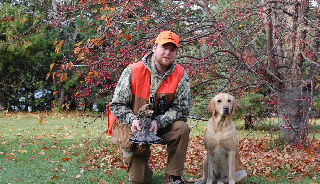Grouse Hunting Techniques
Probably the most important aspect of hunting is that the hunter understands his target in all its' meanings. This can be applied to grouses, but to other birds as well. Knowing the tricks and the habits of the grouse will lead to the creation of grouse hunting techniques, and then to the further development of the hunter's capacities of leading a successful hunt.
Grouses are sneaky and unpredictable. These small and quick birds are even harder to catch, as they respond to only one call, drumming. This sound is impossible for humans to reproduce, and it also occurs during spring, a wrong time for hunting. Therefore the only way to find grouses is to get out there and walk. You can use the smell of your hunting dog as an advantage.
It is very important to acquire information about the grouse's habitat and behavior. This way, you will be able to exploit less territory, but you will be more certain, and you will be able to understand the sound does the grouse makes and the reason behind it.
As far as rifles are concerned, make sure you ease your loads. Heavy loads will wear out your arms and they'll reach the target slower than a long barreled one. Therefore, a 12, 16 or 20 gauge shotgun, with a high speed will definitely kill the grouses, even if they are in a large convey. Also, make sure you approximate the distance properly. Most shoots will be less than 25 yards, but if you use the right cover, make sure you shoot from a close range (from 10 to 20 feet).
There are two methods used by the hunters to catch these small running birds. You can either take them for a walk, so to speak, or use a heavy cover. If you choose the first one, scan ahead at eye level while walking, you never know when a grouse might appear for a few seconds in front of your eyes.
Covers should be made in accordance with two popular spots among grouses: the edge and the trees. Grouse love edge cover because it offers food sources. They can definitely be found where the field meets the road or where the mature forest meets the growing one. During winter, grouses usually stick close to conifers for warmth and shelter. Also, during summer, they feed on the catkins of willows and spruce needles. Those trees are definitely spots you should not miss.
Hunting grouses with dogs will be a certain improvement for your hunting technique. You should teach your dog not to fear the gunshots and be at ease on the field. As becoming a good hunting dog requires many years of practice, never forget to reward your dog after an effort he has made. Teach him all he needs to know step by step and try not to pressure him by expecting more than he can give.
As grouses move from one place to another, regardless of the climate, hunters and dogs must also adapt to any weather conditions. This is part of the strategic planning that is developed before and during the hunt. The physical training is as important as the theoretical one.
Grouses should not be underestimated; in fact, hunters should prepare themselves even harder, for when it comes to learning how to hunt grouses, things are quite complicated. Make sure you have everything planned and that you know all the necessary details.
It is very important to acquire information about the grouse's habitat and behavior. This way, you will be able to exploit less territory, but you will be more certain, and you will be able to understand the sound does the grouse makes and the reason behind it.
As far as rifles are concerned, make sure you ease your loads. Heavy loads will wear out your arms and they'll reach the target slower than a long barreled one. Therefore, a 12, 16 or 20 gauge shotgun, with a high speed will definitely kill the grouses, even if they are in a large convey. Also, make sure you approximate the distance properly. Most shoots will be less than 25 yards, but if you use the right cover, make sure you shoot from a close range (from 10 to 20 feet).
There are two methods used by the hunters to catch these small running birds. You can either take them for a walk, so to speak, or use a heavy cover. If you choose the first one, scan ahead at eye level while walking, you never know when a grouse might appear for a few seconds in front of your eyes.
Covers should be made in accordance with two popular spots among grouses: the edge and the trees. Grouse love edge cover because it offers food sources. They can definitely be found where the field meets the road or where the mature forest meets the growing one. During winter, grouses usually stick close to conifers for warmth and shelter. Also, during summer, they feed on the catkins of willows and spruce needles. Those trees are definitely spots you should not miss.
Hunting grouses with dogs will be a certain improvement for your hunting technique. You should teach your dog not to fear the gunshots and be at ease on the field. As becoming a good hunting dog requires many years of practice, never forget to reward your dog after an effort he has made. Teach him all he needs to know step by step and try not to pressure him by expecting more than he can give.
As grouses move from one place to another, regardless of the climate, hunters and dogs must also adapt to any weather conditions. This is part of the strategic planning that is developed before and during the hunt. The physical training is as important as the theoretical one.
Grouses should not be underestimated; in fact, hunters should prepare themselves even harder, for when it comes to learning how to hunt grouses, things are quite complicated. Make sure you have everything planned and that you know all the necessary details.
General Info
Equipment & Supplies












